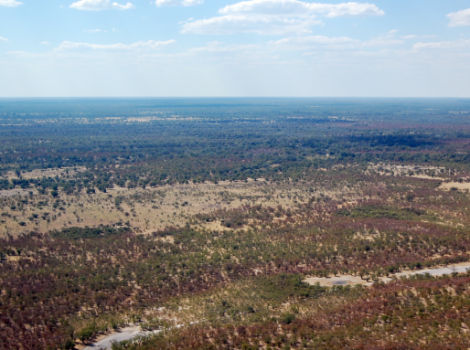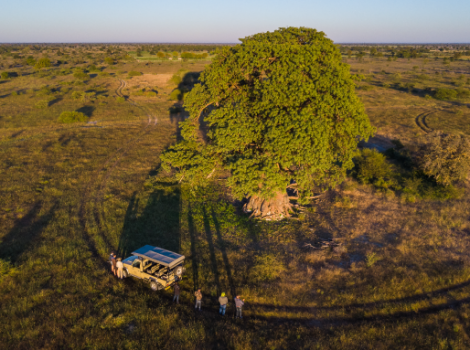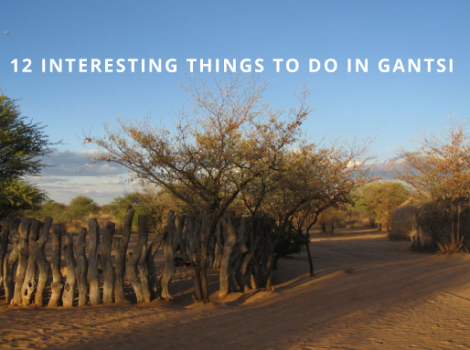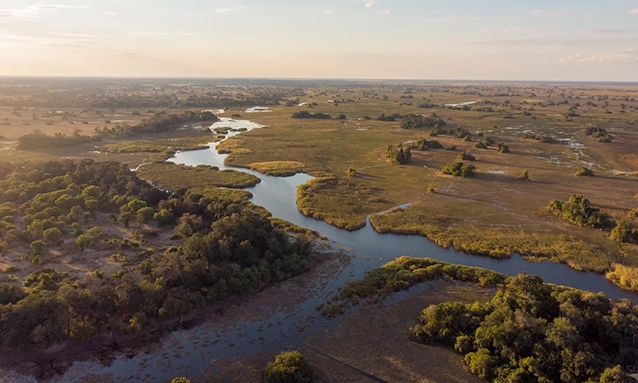
Safari is a Swahili word that means “journey” or “expedition.” It comes from the Arabic word safar meaning “to travel.” Swahili is the most common language spoken in East Africa, but the word safari didn’t appear in the English language until the late 19th century, and was then usually only used when talking about hunting trips in Africa. Today, most people think of “going on a safari” as a game-viewing trip. For the purposes of this story, I’d like to go back to its original meaning, namely “exploring,” and to do that, I’d like to take you on a safari in Botswana’s beautiful and special Okavango Panhandle.
Botswana’s Okavango Delta is, without a doubt, one of the greatest natural sanctuaries in the world. Surrounded by the sands of the Kalahari Desert, this vast maze of meandering channels, waterlily-filled lagoons, and lush green islands is somewhere everyone should visit at least once in their lives.
The Okavango Delta was the 1,000th location to be listed as a World Heritage Site, and is also one of the Seven Natural Wonders of Africa.
The delta is fed by the Okavango River, which flows southeast from Angola and through Namibia’s Zambezi Region before entering Botswana at the small village of Mohembo. Here, the delta spreads out into a strip roughly 7 miles wide; a green mass of dense papyrus and reed beds, floating islands of interwoven underwater vegetation, calm lagoons, and a myriad of twisting channels with constantly changing courses.
Look at a map of the Okavango Delta, and you’ll notice it’s shaped somewhat like a frying pan. The Okavango River is channeled between two steep-sided banks along a roughly 60-mile-long “handle,” before it meets underlying fault lines and floods out to form the Okavango Delta. The delta represents the “pan” part of our analogy; and that is how the Okavango Panhandle got its name! This is not a protected reserve or national park, but there are still vast areas of unspoiled wetlands and wilderness just waiting to be explored.
So now we’ve got ourselves orientated, let’s journey together into the Okavango Panhandle. This is not your classic safari destination; it is so much more.
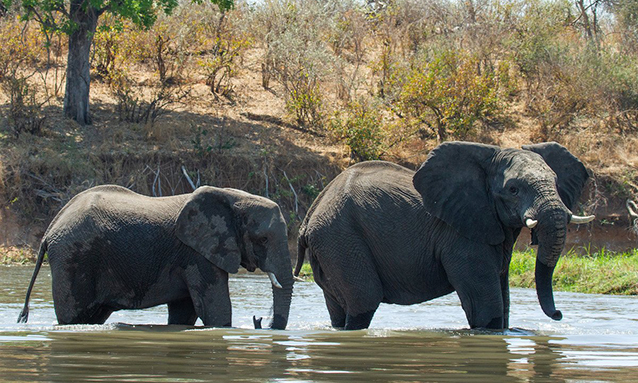
Wildlife Viewing
As I said, this is not the place for a traditional safari. The Okavango Panhandle is not known for its wildlife, and big game viewing is not the main focus or really an option here. Having said that, there are plenty of crocodiles, hippos, elephants, and, my personal favourites, otters. If you are fortunate, you might even catch sight of the shy, secretive, and special swamp-dwelling Sitatunga antelope hiding in the dense reeds.
Outstanding Bird Watching
For the birdwatchers amongst you, this is a wonderful destination for novices and experts alike. Of Botswana’s 616 bird species, more than 350 have been recorded in the panhandle environs, including some Okavango specialties, like the Pel’s fishing owl and the African skimmer.
The papyrus and the reeds along the channels can be thick, and can definitely give the birds an advantage when it comes to hide and seek. Exercise a little patience and you will be rewarded with some special sightings. My personal favourites are the painted-snipes and rufous-bellied herons. The tiny malachite kingfishers are always a treat to see. As we floated quietly down the channel one afternoon, motor off under the watchful eye of a magnificent fish eagle, a kingfisher kept flitting back and forth across the channel, never seeming to sit still and always taking off just as I was about to take a photo! Another spectacular sight is the vibrant-coloured carmine bee-eaters that migrate, gathering to nest in the dry banks of the Okavango River when the water levels are low, and sometimes burrowing their nests as deep as 6 feet into the riverbank.
Fishing
The Okavango Panhandle is one of the prime fishing destinations in Botswana. The fast-flowing, deep waters are ideal for fishing. Fishing here is catch and release, and you can try your hand at catching a diverse variety from African pike to the sleek catfish, as well as tilapia, bass, and bream. In all, 17 species of fish can be caught in the Okavango Panhandle.
Thrilling Tigerfish Experiences
The area is home to one of the world’s most exciting freshwater fish, the tigerfish. Tigerfish up to 22 pounds have been caught in the northern channels. If you’re after a tiger, embrace your adrenaline-fuelled inner angler, cast your rod into the water, and watch for the lightning-quick, olive-coloured back and silvery underbelly of your prey.
During September and October, smaller bait fish find their way into the channels of the Okavango Panhandle, causing a feeding frenzy amongst the thousands of barbel (catfish), some of whom are over 4 feet long. The barbel in turn attract “the tigers” and an incredible feeding frenzy ensues. This is the perfect time for the serious anglers to strike!
Calm Fishing For Tasty Fish
For those looking for a quieter fishing experience, the panhandle offers fantastic fly-fishing for the delicious Okavango bream.
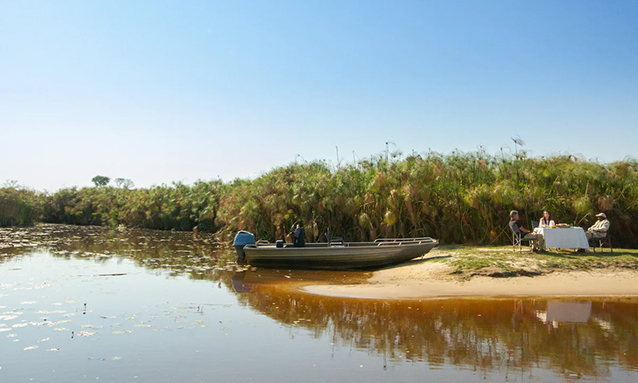
Boat Trips
Activities in the panhandle are mainly focused on the perennial waters of the Okavango River. Boat trips, particularly during sunset, are a wonderful experience. Watch the sun go down on another beautiful day in Africa with a drink in your hand and the warm sun on your skin. Or venture out on a tranquil mokoro (dug-out canoe) at dawn or dusk. Experience this traditional method of transportation as you glide almost silently through the clear blue channels, carving a course through the waterlilies and listening to the creaks, croaks, and calls of various insects, frogs, and birds.
History And Culture
On your typical wildlife safari in Botswana, it’s relatively rare to come across local people and learn about their lives, but here you will see some fishing and cattle farming. A number of local communities live here, their daily lives centred on the permanent waterway of the Okavango River. Meanwhile, just 20 miles from the panhandle lie the Tsodilo Hills, Botswana’s first UNESCO site of cultural significance, home to a large collection of ancient rock paintings.
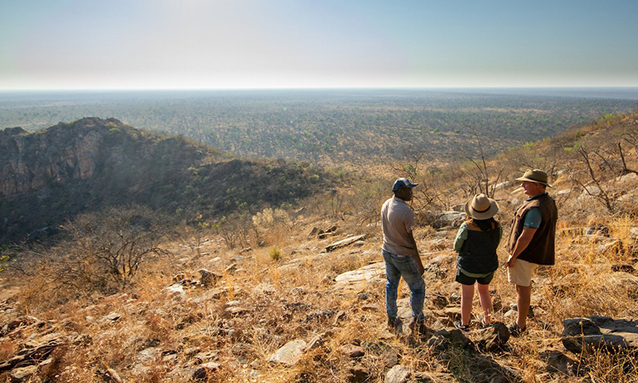
Tsodilo Hills
The panhandle is a great base from which to visit the Tsodilo Hills. In the immense flatness of this arid landscape, four large rocks dramatically rise 1,300 feet above the ground. The largest of the rock formations is known as the Male; a little smaller is the Female; the third is the Child; and the fourth rock is sometimes referred to as an earlier wife, sometimes as another child, or even occasionally as a grandchild.
These hills are the spiritual home of the Basarwa (the San people) and Bantu people. Spread out over 5 square miles, archaeologists have found evidence of early human life dating back as far as 100,000 years ago. The north end of the Female hill is the best sight to visit for rock art. I spent some hours here with a local Baswara guide, learning about the symbolism and ancient traditions associated with the paintings.
There is other evidence of ancient civilisations here, with artefacts including beads, carved bones, and pottery dating back 90,000 years. There is a small museum on-site and I’d recommend you take a guide with you on the walking trails, like we did, to explain and interpret the paintings, and to point out some of the more inconspicuous ones.
Gcwihaba Caves And Aha Hills
Other destinations in this area of historical, cultural, and geological interest are the Gcwihaba Caves (Drotsky’s Caves) and Aha Hills. These locations are extremely remote and visited by very few people. The caves are Botswana’s only network of subterranean caves and pits with incredible examples of stalactites and stalagmites. There is a 3,000-foot passageway through the caves, interlinked by an entrance at either end. The Aha Hills on the Namibian-Botswana border are smaller than Tsodilo and famed as being one of a few remaining destinations where one may still see a San Bushman trance dance.
Pro Tip: We flew to Tsodilo Hills by helicopter from nearby Nxamaseri Island Lodge and I would recommend this as a truly spectacular way to approach the site. You can drive the route, and the road is well maintained.
Getting There
You can drive from Namibia to the panhandle or make the long drive from Maun (the usual jumping-off point for visiting the “pan” part of the panhandle), but I would really recommend flying in. The Okavango Panhandle is the perfect place to visit as an addition to your more traditional game-viewing safari, either after visiting the main part of the delta or perhaps after visiting Chobe National Park. I flew in on a six-seater Cessna plane from Kasane Airport after spending some time at the fabulous Chobe Game Lodge inside Chobe National Park.
Where To Stay
Along the western edge of the Okavango Panhandle, there are a handful of self-drive safari and fishing camps and, on the whole, the area is more low-key and affordable than elsewhere in the delta.
Nxamaseri Island Lodge
I would recommend Nxamaseri Island Lodge as the perfect place to stay. This is a small and intimate lodge, located on a tiny private island in the permanent waters of the Okavango Panhandle. The rooms are quiet havens, elevated above the water and interconnected with raised wooden walkways. Nxamaseri Island Lodge showcases the beauty of the permanent swamps, but without doing away with the creature comforts.
My room had a secluded verandah suspended over the water, perfect for some quiet time alone. I had a spacious bathroom with seemingly endless hot water, and a sublimely comfortable bed, complete with a hot water bottle tucked into it. I felt a real part of the surrounding landscape as I lay in bed at night listening to the sound of hippos splashing and grunting in the darkness outside.
Enhance Your Visit
This last point is really a tip to help you make the most of your time in the Okavango Panhandle, and indeed the rest of Botswana too. I’d recommend you download the Botswana Wildlife App before your trip.
Renowned safari guide Grant Reed, co-founder of Letaka Safaris, has put his vast wealth of knowledge and experience into creating an easy-to-use app that allows you to quickly identify any animal, bird, fish, reptile, flower, or tree you encounter on your safari. It’s the perfect companion to your Botswana travels and is available on both Android and Apple. (You can watch a quick introduction on YouTube.)
The Okavango Panhandle really is one of the world’s last remaining natural sanctuaries. Immerse yourself in the surroundings and experience the undisturbed wilderness. Come to experience the incredible natural beauty, the fantastic birdlife, the incredible fishing, and the fascinating culture and history. This is a special place and one that really deserves a visit.
Article by Sarah Kingdom
Source: https://www.travelawaits.com/2776604/okavango-delta-botwana-best-experiences/

